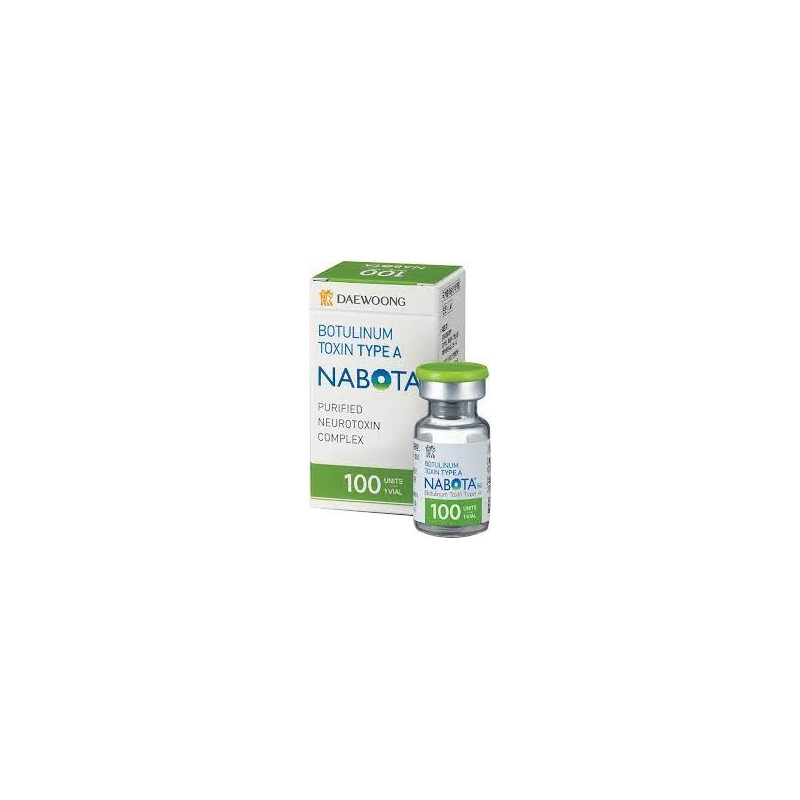



Korean Nabota Botulinum Toxin Type A 100iu anti-aging - Type A botulinum toxin lee-dried powder to be diluted and injected by injection. Ingredients: Clostridium Botulinum Toxin Type A 100 Units. Stabilizing agents likes Human serum albumin 0.5 mg. Isotonic agent: Sodium Chloride 0.9 mg. It appears as a white to yellowish, lyophilized powder for injection in a colourless and transparent vial. It should become colourless transparent liquid when dissolved in the diluent (physiological saline solution). Absolutely not to be used if it smells bad, has lumps or particles or has a cloudy color and appearance.
 International payments
International payments
We accept credit card payments and international wire transfers
 International shipments
International shipments
We ship to the US, UK, Europe and the rest of the world
 Return policy
Return policy
We guarantee the refund or replacement of damaged products
Botox nabota is particularly suitable for temporarily improving the appearance of glabellar wrinkles, both moderate and severe, as long as they are caused by the corrugator muscle and / or the procerus muscle, in adults between the ages of 20 and 65.
The function of Nabota is common to all botulinum toxin preparations, that is to bind the receptors to the distal end of the nerve entering the nerve endings. In this way it is able to inhibit the natural secretion of acetylcholine by limiting nerve conduction. When Nabota is injected by intramuscular injection, it causes localized muscle paralysis, as the puncture will be done in specific areas called injection points, thus causing localized muscle paralysis by chemical denervation. In this condition the muscles themselves are chemically denervated and weaker, but they do not lose their ability to develop, so they can generate new nerves and nerve stimulation over time, which is why any treatment with botulinum toxin is not definitive.
Botulinum toxin Nabota type A is also used in the medical field: it is particularly indicated for the treatment of blepharospasm associated with dystonia, including benign essential blepharospasm, hemifacial spasm or seventh nerve disorders in 12-year-old patients, for the correction of strabismus in patients over 12 years of age for the treatment of spasmodic torticollis or cervical dystonia in adults, for the treatment of dynamic clubfoot deformity due to spasticity in pediatric patients with infantile cerebral palsy, and for the temporary treatment of activity-associated glabellar lines corrugator and / or procuring muscle in adult patients less than 65 years of age It is also indicated in the management of focal spasticity, including the treatment of stroke-associated spasticity in adults.
Each patient is different, therefore as regards the dosages and especially the post injection course, each one faces his own path. The various applications in patients with glabellar lines treated with five times intramuscular injection of 0.1 mL (4 U / 0.1 mL) for a total of 20 IU of Nabota, on average saw improvements between the top 2 and top 5 days of the first treatment, in some cases up to 14 days. All this, without incurring particular side effects in addition to those normally found in treatment with botulinum toxin type A.
As with all treatments with neurotoxins, for aesthetic and non-aesthetic treatments, there are precautions to be strictly observed to avoid contamination and reduce the risk of botulism and Nabota ineffectiveness. The vials should be stored in the refrigerator at a temperature between 2 and 8 degrees centigrade. If the drug has been activated and diluted with the appropriate solution, it must be administered within 24 hours, well stored in the refrigerator between 2 and 8 degrees centigrade.
All bottles, including those that have passed the expiration date or those in direct contact with the product, should be discarded and disposed of as if they were medical waste. If the country provides for inactivation of the toxin, it is recommended to use hypochlorite diluted in a proportion between 0.5 and 1% before disposal.
There may be a real risk of contamination when discomfort or particular symptoms occur, such as weakness, diplopia, ptosis, dysphagia, dysphonia, dysarthria, urinary incontinence, difficulty in swallowing, speaking or breathing. These episodes can occur within hours or weeks of treatment. Timing is very important for administering the antidote and limiting any damage.